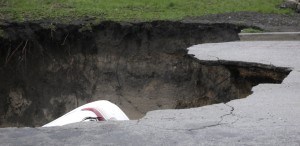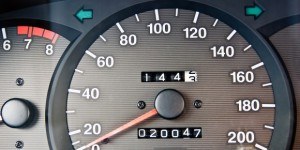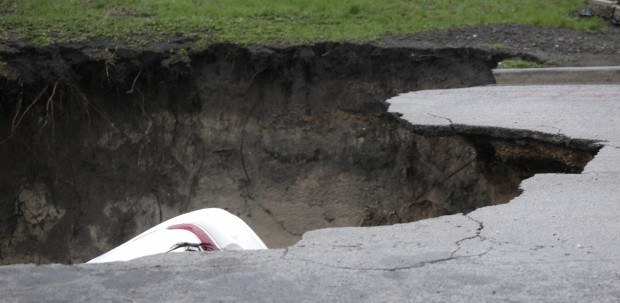A rainstorm pummeling the Chicago area ripped open a sinkhole Thursday that swallowed three cars, injuring one driver badly enough that he had to be hospitalized. Blasts of torrential rain and widespread flooding forced authorities to shut segments of major expressways, and hundreds of flights were scrapped.
Schools were closed, commuter trains slowed to a crawl and a local emergency agency to the north, in Lake County, drafted jail inmates to fill sandbags. Swaths of central Illinois were also affected as authorities predicted record flood stages, and Gov. Pat Quinn declared an emergency.

The gaping sinkhole opened up a residential street on Chicago’s South Side just before 5:30 a.m. after a cast iron water main dating back to 1915 broke during the massive storm. The hole spanned the entire width of the road and chewed up grassy areas abutting the sidewalk. Two of the cars that disappeared inside had been parked, but a third was being driven when the road buckled and caved in. Only the front-end of one of the vehicles could be seen peeking up along the edge of the chasm.
The driver was taken to Northwestern Memorial Hospital with non-life threatening injuries, said Chicago Police Department spokesman Mike Sullivan.
Tom LaPorte, a spokesman for the city’s water department, said the force of the heavy rain or the movement and weight of the rain-soaked ground could have caused the pipe to crack open.
In the street outside the Willis Tower, an overwhelmed sewer system sent water gushing geyser-like from manholes with such force it rattled the heavy covers.
“The water will come out any way it can,” LaPorte said. He said there have been hundreds of reports of flooded basements.
In many places, people were stranded in flooded homes, prompting authorities and, in some cases, family and friends to come to the rescue.
Nick Ariano, of Wheaton, helped rescue a friend’s grandmother in nearby Lisle, to the west of Chicago. The woman, in her mid-80s, was trapped in her split-level home, which was fast filling with water. Her son had gone to help but also got trapped.
Ariano, another friend and the woman’s grandson, Keith Andrzejewski raced to a sporting goods store to buy inflatable rafts and then paddled out to the home beside a branch of the DuPage River, which had begun to top a levee.
They were able to get the woman, Millie Andrzejewski, and her son, Robert, to safety before police or fire department could arrive.
Ariano said she was in good spirits and even laughed at the memory of another bad flood there when she was 18. The three friends kind of enjoyed the raft ride, too, despite the eeriness of floating over submerged cars and mailboxes.
“As kids growing up, we used to raft down the river,” he said with a laugh.
In the city, workers were furiously filling sandbags and putting up barricades along the north branch of the Chicago River in the Albany Park neighborhood in the hopes of keeping the river from rising over its banks, LaPorte said.
Authorities opened locks on the river to allow the storm-swollen waterway to rush out into Lake Michigan, a step that is not uncommon during storms.
The river was diverted away from the lake more than a century ago to keep pollution out of the lake, the source of the city’s drinking water. But workers had to “re-reverse” the flow because huge tunnels and reservoirs designed to hold storm water were full or near capacity, said Metropolitan Water Reclamation District spokeswoman Allison Fore.
Other parts of northern Illinois and central parts of the state also saw storm damage, prompting Quinn to issue an emergency declaration allowing the state to access federal resources, including generators, pump systems sandbags and additional funds.
A lightning strike knocked out power to a northern Illinois nuclear plant for several hours Wednesday night, but emergency generators kicked in to keep the site in rural LaSalle County running, the U.S. Nuclear Regulatory Commission said.
Across Illinois, authorities were expecting record flood stages.
“Based on the forecasting right now, we expect to meet and exceed historic flood levels,” said Jonathon Monken, director of the Illinois Emergency Management Agency. He added that officials expect “in excess of what we saw in Chicago in 1986 and 1987; the Mississippi, we expect it to be in excess of what we saw in 2008, all of which were very significant floods.”
The rain, combined with strong winds, downed power lines, flooded homes and toppled big-rigs across central Illinois.
On roadways throughout the Chicago area, vehicles were stalled in standing water that was nearly up to car windshields in some places. Several expressways had to be at least partially closed.
Around 840 flights in and out of O’Hare International Airport were canceled, according to the aviation tracking website FlightAware.com.
Thursday’s storm drenched the airport with more than 5 inches of rain.
(Associated Press writers Don Babwin and Tammy Webber in Chicago, David Mercer in Champaign and Regina Garcia Cano in Springfield contributed to this report.)
(AP Photo/M. Spencer Green)





















 Aon Adds to List of Brokers Suing Howden US for Alleged Poaching, Theft
Aon Adds to List of Brokers Suing Howden US for Alleged Poaching, Theft  Rebuilding Negotiation Talent: Why This Skill Is Missing and How to Fix It
Rebuilding Negotiation Talent: Why This Skill Is Missing and How to Fix It  A Practical Blueprint: The Five Plays of an Innovation Culture
A Practical Blueprint: The Five Plays of an Innovation Culture  Acrisure to Buy MGA Vave From Canopius
Acrisure to Buy MGA Vave From Canopius 




